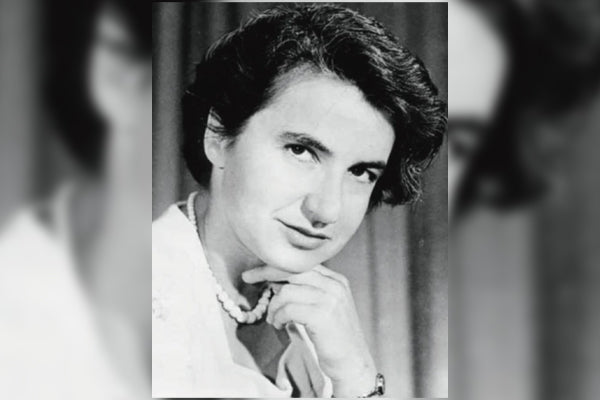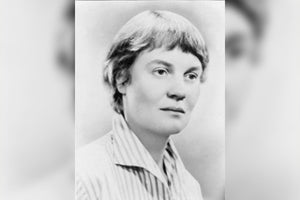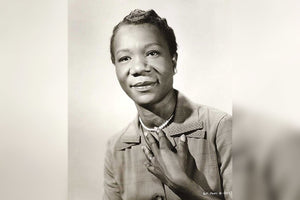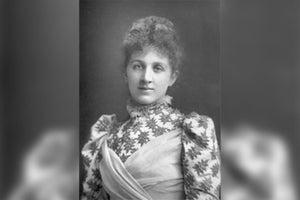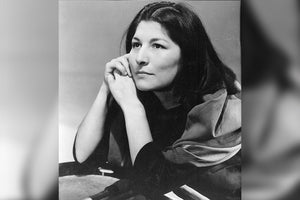Rosalind Franklin was a scientist whose work was very important in discovering the structure of DNA (the molecule that contains the genetic code for all plants and animals) she used a scientific method to take pictures of DNA. These pictures showed that DNA has a structure called a double helix, which looks like a ladder twisted into a spiral.
Rosalind’s work helped other scientists to understand the structure of DNA and to find out how genetic information is passed from parents to their children.
This was a very important moment in the history of medical science.
Your body uses genetic information to decide all sorts of things, for example,
the color of your eyes, or how tall you are. Genetic information also helps us to understand about how diseases and illnesses are caused, and how we might be able to treat them.
Rosalind’s scientific work also helped us to see the tiny structures of other things too, such as coal, graphite, and viruses.
Four facts about Rosalind Franklin:
- Franklin loved traveling and backpacking
- After DNA, the discoveries continued with tobacco viruses
- She worked until the last breath
- Before DNA, she studied the holes in coal

Download this biography for kids
Inspirational Quotes from Rosalind Franklin:
"Science and everyday life cannot and should not be separated."
"Science, for me, gives a partial explanation for life. In so far as it goes, it is based on fact, experience and experiment."
"In my view, all that is necessary for faith is the belief that by doing our best we shall come nearer to success and that success in our aims (the improvement of the lot of mankind, present and future) is worth attaining...I maintain that faith in this world is perfectly possible without faith in another world."
Biography:
Rosalind’s childhood
Rosalind Elsie Franklin was born in London on 25th July 1920 into a wealthy family. Her father, Ellis Arthur Franklin, was a merchant banker and later a teacher, and her mother was Muriel Frances Waley.
Rosalind had three brothers and one sister and she was the second child in her family. At school she excelled at science, Latin, and sports. At that time, girls were not encouraged to study subjects like science but Rosalind had an excellent scientific mind. In her spare time she liked to make things, draw pictures, take photographs, and read books.
Rosalind the scientist
When she was 18, Rosalind went to study natural sciences at Newnham College in Cambridge and she specialized in chemistry. The Second World War was happening when Rosalind finished her studies.
Rosalind used her skills to study the fine structure of coal. This work was useful during the war for understanding how efficient coal would be as fuel and for producing useful devices such as gas masks. She was awarded a PhD (the highest type of university degree) for this work when she was 25. After the war, Rosalind moved to Paris to work with a French scientist called Jacques Méring. Here, she became very good at using the scientific method called x-ray diffraction.
X-ray diffraction works by sending a beam of x-ray radiation through an object to
a photographic film on the other side. The x-ray beam bounces off the object at different angles, causing a pattern of spots on the photograph. This pattern of spots tells us about the tiny structures inside the object. These tiny structures are so small we can’t see them with our eyes, or even with a microscope, so we have to use this kind of scientific method to find out.
At that time, women who worked in science laboratories were usually only employed as assistants, not as scientists. So Rosalind’s male co-workers did not always accept her as an equal and she struggled to be respected as a scientist.
Rosalind’s discovery
In 1951, when Rosalind was 30, she started to work at King’s College in London. Here, she used the x-ray diffraction method to study the structure of DNA.
Rosalind had a difficult relationship with one of her co-workers, Maurice Wilkins. They had very different personalities, so they did not work very well together and chose to work separately.
Rosalind’s work showed some important facts about DNA and convinced her that the structure of DNA was a double helix (like a ladder twisted into a spiral). This was different from what other scientists thought.
Two other scientists were trying to find out the structure of DNA at the same time as Rosalind and Maurice. They were called James Watson and Francis Crick and some of Rosalind’s work helped them when they were trying to build a model of what DNA looks like

DNA Double Helix
In 1953, James Watson and Francis Crick had nearly completed their model of what they thought DNA looks like, but their model was not quite right.
Without asking or telling Rosalind, Maurice showed James Watson one of Rosalind’s photos produced by x-ray diffraction. This photo gave James Watson and Francis Crick the final piece of information they needed to show the true structure of DNA.
Recognizing Rosalind’s contribution
Although Rosalind’s work was so important to James Watson and Francis Crick’s model of DNA, she was not mentioned in the article they published about this. Sadly, Rosalind developed cancer and died in 1958 when she was just 37 years old
Four years later, in 1962, James Watson, Francis Crick and Maurice Wilkins were awarded the Nobel Prize for their work. The Nobel Prize is awarded once a year for important contributions to science.
Rosalind was not included in being awarded this prize.
People cannot be awarded this prize after they have died. But even if she was alive, it seems that she still would not have been included.
These days, Rosalind’s contribution to the discovery of the structure of DNA is well known, and some buildings, laboratories, awards and colleges have been named after her.
![]() Fast Shipping
Fast Shipping![]() Subscribe to our Newsletter
Subscribe to our Newsletter![]() 🌟 New Global Competition 🌟
🌟 New Global Competition 🌟